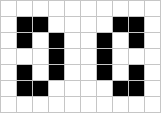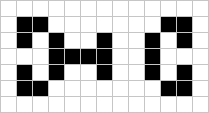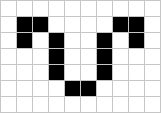Reciprocating agar
Reciprocating can be the name of an agar as well as an adjective describing it in the sense of the dictionary definition: "passing back and forth." What is passed are horizontal domino sparks sandwiched at three-cell vertical intervals between thin restraining single cell walls. The congestion of having four neighbors makes the dominoes disappear just as new dominoes appear straddling the gaps along the wall. Pairing gaps on one side of the wall with dominoes on the other side leads to an infinite line agar, an interesting period two blend of the static Zebra stripes agar and the oscillating Venetian blinds agar.
By closing off the vertical stripes and bracing the rest of the figure with lateral induction coils, a wide variety of finite oscillators can be created, of which many of the smallest instances have already been found and named. Should their shape permit packing them together, numerous tiling agars can also be recognized.
| pattern | comment | image |
|---|---|---|
| Spark coil | The smallest pattern in this series is a spark coil, bounded by two houses |  |
| Piston | Spark coils can be extended horizontally indefinitely, their domino sparks alternating sides of the wall. |  |
| Test tube baby | The same effect with a different boundary, which resembles the Hat configuration |  |
| tt-baby cells | Without the induction coils and with an overhead closure, the 4×5 test tube baby cell can be extended, acting as its own induction coil. | |
| elongated tt-baby cells | They can also be elongated vertically in two cell increments (preserving a total odd height), still acting as their own induction coils as mutual lengths permit. Namely, matching or with a two cell parity preserving overshoot or undershoot. | |
| A Reciprocating Wick | Without the induction coils and keeping the overhead closure, the 4×5 test tube baby cell can be extended, still acting occasionally as its own induction coil. The result is analogous to the random walks characteristic of domino wicks bordering Lakes, (or marshland agars) or Snake walks in herparian agars. | |
| A Reciprocating Agar | Not only wicks, but full agars, are possible. Suitable (odd)x(odd) packing must be found for the interstices, leaving no exposed three cell intervals on any wall. |
As a further example of the complexity which is possible, the figure to the right combines some elongated test tube babies of lentgh 11 in both horizontal and vertical positions, guarded in various ways. They can support each other when their lengths are either the same, or 2 cells longer or shorter. They can also coexist alongside the thinner extended beehives, subject to the same condition. The rings participating in this particular figure are of just the right size to be internally supported by some beacons, also of period 2.
Although the example is squared up nicely, it is merely evidence of a large variety of similar agars, obtained by the process of tiling rectangles by rectangles.